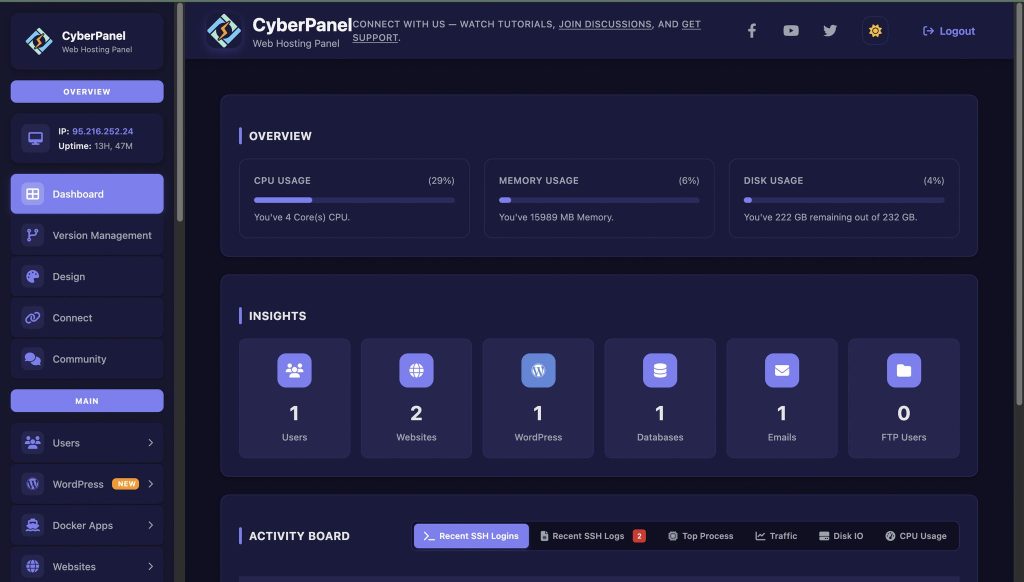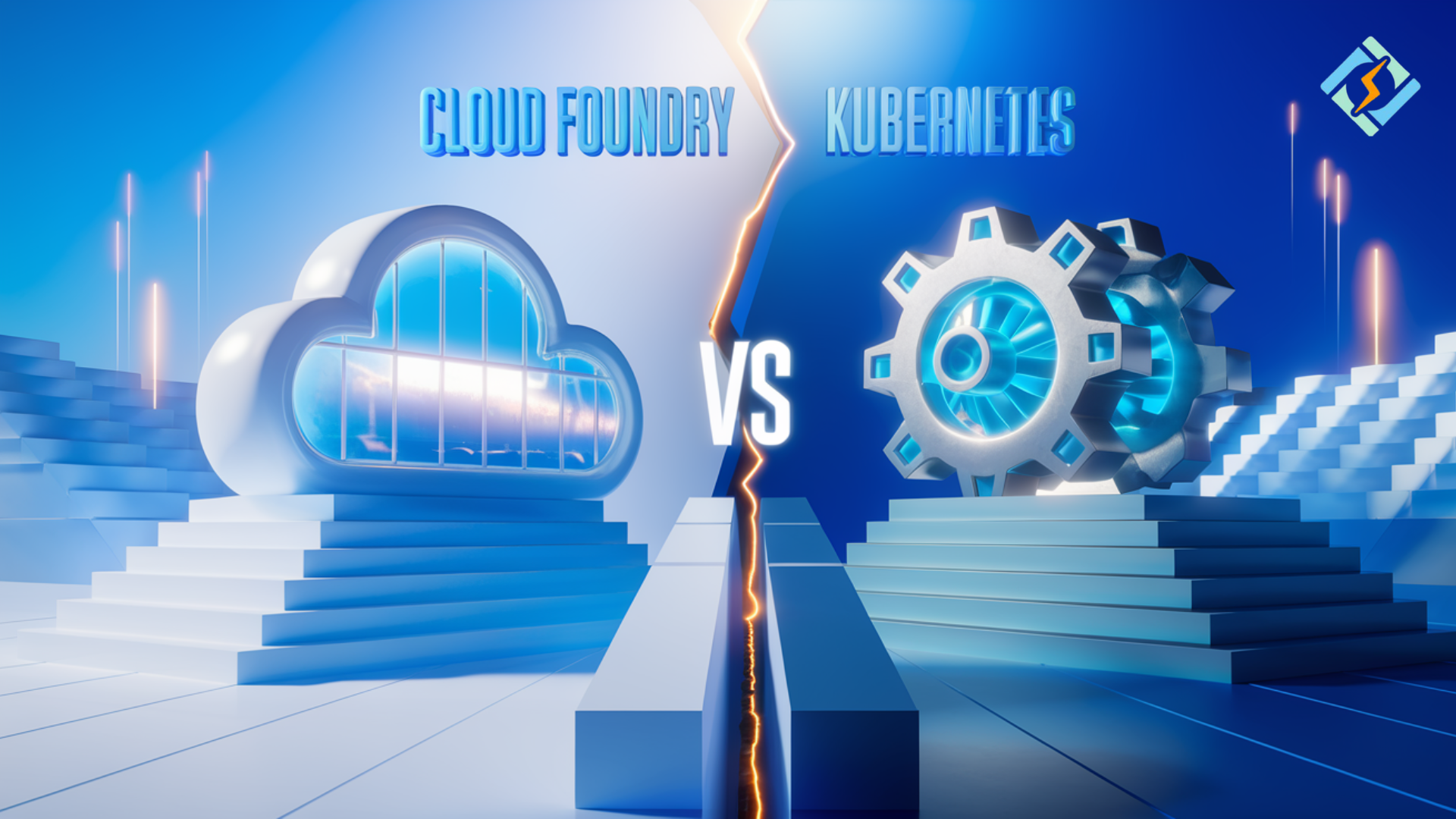Every cloud-native development needs flexibility and efficiency. We have two powerhouses that always stand out, i.e., Cloud Foundry & Kubernetes. Cloud Foundry is a highly productive Platform-as-a-Service (PaaS). Kubernetes is a robust container orchestration system. Both offer scalability and automation, but they serve different platforms. We are going to compare Cloud Foundry vs Kubernetes.
In this article, we are going to discuss what each platform offers, their core differences, and how to know which one fits your workflow. Let’s compare Cloud Foundry vs Kubernetes.
What is Cloud Foundry?
Cloud Foundry is an open-source and mature PaaS. It is designed to reduce time-to-market for the applications. Moreover, it treats infrastructure as a utility, handling deployments, scaling, logging, and routing behind the scenes.
Key Features
The following are the key features of Cloud Foundry:
- cf push: It makes code live in seconds via buildpacks
- Built-in routing and autoscaling
- Service bindings: It can plug into databases, caches, or messaging with zero manual config
- Multi-cloud support: It can deploy on AWS, GCP, Azure, or on-prem
- Opinionated workflows: It limit complexity, so developers focus on code
Think of Cloud Foundry like ordering an app from a digital storefront. You supply the source, and the system takes care of the rest.
What is Kubernetes?
Kubernetes is the famous container orchestration system across all major cloud providers. It’s major focus is “plumbing” of infrastructure. It includes scheduling containers, maintaining desired states, scaling, and managing networking.
Get exclusive access to all things tech-savvy, and be the first to receive
the latest updates directly in your inbox.
Key Features
Here are the features of Kubernetes:
- Pods, Deployments, Services: For lifecycle management
- Helm: The package manager for Kubernetes
- Operators and CRDs: For running databases, analytics engines, and custom controllers
- Cloud portability: Match infrastructure from bare metal to managed Kubernetes
- Modular ecosystem: Monitoring, logging, CI/CD, service meshes, and more
Pivotal Cloud Foundry vs Kubernetes
Let’s discuss Kubernetes vs Pivotal Cloud Foundry.
In enterprise environments, when discussing Cloud Foundry, it’s typically Pivotal Cloud Foundry (PCF)—the commercial distribution of the Cloud Foundry project maintained by VMware. While Cloud Foundry is open-source, the PCF brings commercial enterprise and support, built-in integrations, and easier upgrades.
Comparing and finding where Pivotal Cloud Foundry and Kubernetes fit:
Enterprise Consideration:
Pivotal Cloud Foundry offers the strong enterprise integrations you’d expect with products such as Spring Boot support, enterprise SSO, and monitoring tools. Kubernetes is generally far more open; as such, you generally have to assemble these integrations yourself.
Developer/User Experience:
Pivotal Cloud Foundry’s developer/user experience is highly opinionated—cf push is all you must do to get your app deployed. With Kubernetes, you will typically create and deploy Docker images, create Helm charts, and then require custom deployment and configurations.
Operational Complexity:
In Pivotal Cloud Foundry, you abstract a lot of the operational and infrastructure complexity. With Kubernetes, you have added complexity, and a lot of operational responsibility is passed back to the ops team to configure networking, scaling, and observability
Use Case Fit:
Enterprise users who want to deliver applications rapidly with vendor support will typically choose Pivotal Cloud Foundry. DevOps-skilled teams who want full flexibility will generally favor Kubernetes.
Cloud Foundry vs Kubernetes: Major Points of Difference
Here are a few points of difference for Kubernetes vs Cloud Foundry:
Flexibility and Control in Infrastructure
- Kubernetes is a tool for teams that really want full power over things. You direct how containers are scheduled, scaled, and linked. You also pick your networking and monitoring solutions, as well as your storage.
- Cloud Foundry hides those layers for you and takes care of the strategies and scaling, which means not much room for customization, but it lessens complexity.
Security and Compliance
Security features provided by both Cloud Foundry and Kubernetes are also solid.

- Cloud Foundry: has native identity management, automated patch management and compliance-friendly defaults.
- Kubernetes: has RBAC and network policies and secret management, but there is manual configuring for compliance.
In short, for any of the finance or healthcare industries, baked-in compliance from Cloud Foundry is a major plus factor.
Resource managing and the cost efficiency
- Depending on how well each platform fits your needs, cost efficiency will vary:
Cloud Foundry: Saves developer time (lower operational cost) and needs a quite robust infrastructure underneath. - Kubernetes saves infrastructure cost through maximum resource use, but demands much more in DevOps talent.
Limited DevOps resource organizations generally consider Cloud Foundry more cost-effective, whereas robust DevOps teams prefer Kubernetes.
Cloud Foundry vs Kubernetes: Ultimate Comparison
| Feature | Cloud Foundry | Kubernetes |
|---|---|---|
| Abstraction Level | High – Application-centric | Low – Container/Infrastructure-centric |
| Deployment Complexity | Extremely low (cf push) | High – requires config files and manifests |
| Learning Curve | Gentle pace | Steep – ventilation of YAML, networking, schedulers |
| Ecosystem Maturity | Stable but smaller | Expansive (Operators, Helm, service mesh) |
| Use Case Focus | Rapid app delivery | Complex distributed systems with control |
| Maintenance Load | Minimal | High – you manage more layers of the stack |
| Ideal For | App developers | DevOps / Infrastructure engineers |
| Cloud Agnostic Support | Built-in | Built-in and widely adopted |
Cloud Foundry vs Kubernetes: When to Choose
Now, we are going to discuss when to choose Kubernetes and Cloud Foundry:
When to Choose Cloud Foundry:
- You can use Cloud Foundry when you want to deploy apps in seconds without devoting time to infrastructure.
- You can also choose it when you prefer developer velocity.
- You can also choose it when you operate multiple clouds or want a consistent platform across environments.
- You should choose Cloud Foundry when your priority is convention over configuration.
Hence, Cloud Foundry delivers apps smoothly with minimal friction. It is ideal for SaaS users, startups, and dev teams focused solely on code.
When to Choose Kubernetes:
- You should choose Kubernetes when you want microscopic-level control over networking, storage, and compute.
- You should choose it when you are operating a large-scale, multi-service architecture requiring custom load balancing, security, or auto-scaling logic.
- You can also choose Kubernetes when you demand full infrastructure portability across clouds.
- You should choose it when you need to deploy not just apps, but complex stacks like AI inference, streaming pipelines, or IoT services.
Hence, Kubernetes provides infrastructure engineers full toolbox flexibility. If you want to tinker, customize, and optimize every layer, Kubernetes delivers.
Can You Use Both Cloud Foundry & Kubernetes?
You can use both Kubernetes and Cloud Foundry. You can use ‘cf-for-k8s’ for that purpose. Cloud Foundry now runs on Kubernetes. If you are a developer, you can write cf push to deploy, while operators manage via Kubernetes resources. This hybrid model will supercharge your productivity without losing flexibility.
Common Misunderstandings:
Many assume Kubernetes has “replaced” Cloud Foundry. That’s not entirely true. Cloud Foundry itself adopted Kubernetes as part of its evolution (through cf-for-k8s). In practice, the two can even complement each other: Cloud Foundry simplifies the developer experience, while Kubernetes provides the container orchestration backbone.
Future Trends: Where Are They Headed?
- Cloud Foundry is getting restructured to be able to connect with Kubernetes more effectively.
- The Kubernetes community is growing its network to embrace AI/ML usage and to make the technology more self-managing through advanced Automation.
- The Industry is gradually shifting towards convergence, where PaaS ease of use is combined with control.
Role of CyberPanel in Cloud-Native Deployments

CyberPanel, a modern web hosting control panel, can complement CF and k8s. Here is how:
- Admin UI for App Components: Through CyberPanel, you are empowered to administer public websites, databases, SSL, and DNS services even if your backend is running on Cloud Foundry or Kubernetes.
- Quick App Shells: CyberPanel can be employed to deploy front-end shells, then CF or K8s can be used for backend services.
- Bridges DevOps Gap: Web administrators can operate CyberPanel’s interface comfortably and efficiently without having to deal with YAML or CLI.
The control plane for developers or site managers working with Cloud Foundry or Kubernetes backend is what CyberPanel should be compared to.
People Also Ask
How auto-scaler in CF differ from HPA in Kubernetes?
CF scales based on app load automatically. Kubernetes HPA can scale using CPU, custom metrics, or third-party tools.
Does Cloud Foundry support stateful workloads?
Yes. CF supports stateful services via service bindings or external storage services.
In CF and k8s, which integrates better with CI/CD pipelines?
Both support CI/CD, but Cloud Foundry’s cf push makes app deployment seamless. Kubernetes gives more control via pipelines like Argo CD or Jenkins X.
Does Cloud Foundry support containers?
Yes, but it manages containers behind the scenes, unlike Kubernetes, where you manage them directly.
Wrapping Up!
To sum up, the decision between Cloud Foundry vs Kubernetes is yours. Here is a quick wrap-up for you:
- Choose Cloud Foundry if developer velocity and simple app deployment are most important.
- Choose Kubernetes if you need flexibility and extensibility of infrastructure.
- Choose cf-for-k8s if you want both of these.
This article should eliminate ambiguity about both the developer and operations side, so you are confident in your selection of a cloud-native platform.
Looking to scale up your strategy? Choose the platform that supports your future intentions. Start exploring!



